ALMUTASIM MALIK ADAM ELHAJ1 ELTAHIR MOHAMED HUSSEIN 2
Omdurman Islamic University, Faculty of Computer Science and Information Technology, Department of Computer Science, Sudan.
Email: almutasim.cs85@gmail.com
2. Associated Professor. Sudan University of Science and Technology (SUST) College of Engineering
Affiliation
HNSJ, 2022, 3(9); https://doi.org/10.53796/hnsj3922
Published at 01/09/2022 Accepted at 19/08/2022
Abstract
Cloud computing is a kind of Internet-based computing that provides and shared processing resources and data for other systems and devices on demand. It also supports e-learning in the cloud environment. E-learning needs high-resolution content. The paper presents, the idea of creating a new service. It is a high- professional quality video service via the black box in the cloud environment. This idea helps deal with a large number of students dealing with high quality videos at the same time. This idea also helps deal with different operating systems and different devices. The findings of the paper are, creating a new service in a computer cloud environment (high- professional quality videos -as-a- Service (HPVaaS)), using the black box algorithm through which high- professional quality videos pass, and also dealing with a large number of students, dealing with high- professional quality videos at the same time, via the black box algorithm. Data obtained in videos high- professional quality and tools used UML, HTML, JavaScript, and PHP.
Key Words: HPVaaS, E-learning, IaaS, PaaS,SaaS.
1.Introduction
Cloud computing was conceived as the next generation of distributed/utility computing. is defined as a model for enabling an appropriate network upon request to access a common set of configurable computing resources (e.g., networks, servers, storage, applications and services) that can be quickly supplied and launched with minimal administrative effort or interaction with the service provider. There are five basic features, three service models and four cloud computing deployment models. The main characteristics are the pooling of resources independent of location upon request, extensive network access, rapid resource flexibility, and measured service. The three main service models are software as a service and platform as a service and infrastructure as a service. Publishing models include private cloud, public cloud, community cloud, and hybrid cloud. At present, the cloud computing model can offer any conceivable form of services, such as computational resources for high-performance computing applications, web services, social networks, and communications services.[1]
Nowadays, with the advent of affordable high-speed Internet connections, distributed computing is becoming a predominant software development paradigm. Applications are developed for, and made available within, distributed infrastructures, where users can easily access remote services and exploit remote resources from their local workstation, laptop, palmtop device and/or mobile phone.[2]
In this paper, we’re going to talk about three sections. Section one Introduction, contain Problem Statement, Aims and Objectives, Contribution, Methodology, Section two contain background, and related works Section three System Overview which contain (System Analysis, Application services component, Computational of black box, black box algorithm, System Implementation). Section four Conclusion.
1.1 Problem Statement
How to leverage the black-box approach for performance estimation using distributed editing of the high professional-quality video.
Delay increasing when work high professional-quality video under cloud computing environment in Real-time, without black-box.
1.2 Aims and Objectives
Aims of this paper’s create a new service in the computer cloud is to service high-quality videos. Objectives of this paper’s High- professional quality videos are played by improving the black box to increase its speed and improve its performance in good image, especially when a large number of users are handled through high- professional quality videos, especially in the field of e-learning (for example, medical and engineering fields).
1.3 Contribution
create new services high professional-quality video under cloud computing environment in Real-time.
1.4 Methodology
The Methodology of this research Design new framework to black-box algorithm for high professional-quality video under cloud computing environment in Real-time., using data collection; use scientific paper, books, and internet resources, and data Analysis use UML.
2.Background and Related Works
2.1 Background
In the Cloud Computing model, distributed applications are developed by Software-as-a- Service (SaaS) providers, by means of tools made available by Platform-as-a-Service (PaaS) providers, for being deployed over the resources made available by Infrastructure-as-a- Service (IaaS) providers. There are three main classes in the cloud services stack which are generally agreed upon:
- Infrastructure as a Service (IaaS), which refers to the provision of ‘raw’ machines (servers, storage, networking and other devices) on which the service consumers deploy their own software (usually as virtual machine images).
- Platform as a Service (PaaS), which refers to the provision of a development platform and environment providing services and storage, hosted in the cloud.
- Software as a Service (SaaS), which refers to the provision of an application as a service over the Internet or distributed environment. [3]
A black box is a device, software, system or object which can be viewed in terms of its inputs and outputs (or transfer characteristics), without any knowledge of its internal workings. Its implementation is “opaque” (black).[4]
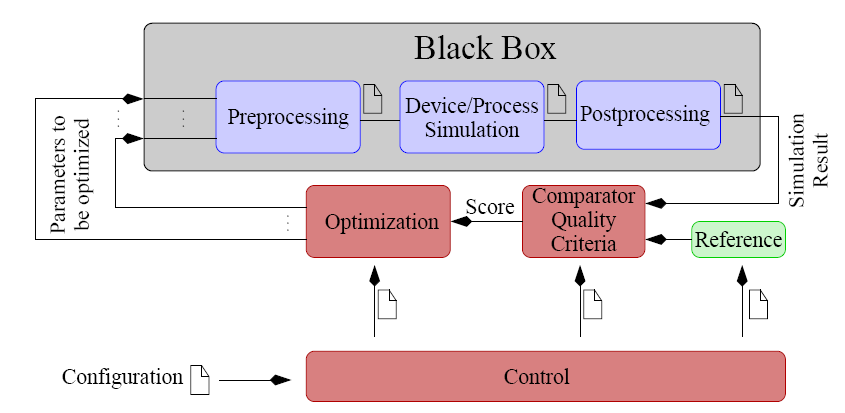
Figure (1): Black Box Approach.
E-learning cloud is the cloud computing technology in the field of e-learning, which is a future-learning infrastructure, including all hardware and software computing resources to engage in e-learning. after the virtual computing resources, they can be in the form of services for educational institution, student and businesses to lease computing resources.
e-learning cloud architecture is divided to five main layers, hardware resource layer and software resource layer, resource management layer, server layer and business application layer.
1- hardware resource layer: it is located at the lowest level of the cloud middleware service, the basic computing power, such as physical memory, CPU, memory layer is provided by the layer.
2- software resource layer: this layer mainly is combined with operating system and middleware.
3- resource management layer: the layer is key to achieve loose coupling of software and hardware resources.
4- server layer: there are three levels of services in cloud computing are SAAS (software as a services) and PAAS (platform as a services) and IAAS (infrastructure as a services).
5- business application layer: the e-learning key is different from other cloud is located in e-learning application layer, which represents the major e-learning business logic, composed of expanded upon a group of e-learning components. e-learning application layer mainly consist of content production, educational objectives, content delivery technology, assessment and management component.[5]
2.2 Related Works
Some of the previous scientific papers explain, in their handling of the black box in the computer cloud environment.
study Darja Krushevskaja and others [6], in address “Understanding Latency Variations of Black Box Services”. the problem is to understand and explain the brief time of arrival in terms of a few observed features. Understanding the profile of cloud services is a fundamentally important problem. They suggested a synthesis amount that we call a multidimensional f scale and provided algorithms to use to determine the appropriate subset of features that explain the time of arrival. General framework for understanding the performance of arbitrary black box services. the results are conducting a detailed empirical study using synthetic data.
study David R. and others [7], in address “Rectify: Black-Box Intrusion Recovery in PaaS Clouds”. the problem is the correlation between requests received and data issued to the database. It wants to avoid such modifications. They proposed a new approach that would allow intrusion effects in web apps to be eliminated without any software modifications, thus taking into account that the app is a black box. the results are a black box recovery service for PaaS applications. Correction is a new approach to restoring attacked web applications.
study Shripad Nadgowda and others [8], in address “, DéjàVu: Bringing Black-box Security Analytics to Cloud”. instead of rewriting working security solutions from data, we explore how to reuse existing security solutions as black box analytics in the cloud. They say the results are the design and implementation of DéjàVu. They thoroughly validate DéjàVu by running real enterprise security software such as black box apps when we actually execute.
study John Emmons and others [9], in address Cracking open the DNN black-box: Video Analytics with DNNs across the Camera Cloud Boundary”. the developments in deep neural networks (DNNs) and the wide dissemination of video cameras have fuelled the need for video analysis systems. Despite the rapid progress in system design, current systems treat DNNs largely as “black boxes” and either fully post models on camera or compress videos for analysis in the cloud. New application scenarios that include shared inference between cameras and cloud, and continuous online learning for large camera deployment. The proposed a new approach to inferring DNN in smart systems, the structure of “brain division,” where the DNN account is divided between the camera in the field and the cloud data centre that runs through the black box.
3.System Overview
In this section, we will talk about the idea of the paper, in creating a new service for high- professional quality videos in the cloud’s computer environment. Especially in the field of e-learning (e.g. in the field of medicine or engineering), we need the black box to handle high professional quality videos, and deal with the presence of a large number of students at the same time. Dealing with different systems, this is why the black box was used for high quality videos. This section contains, System Analysis, Architecture of The New System, Application services component, Computational of black box over high- professional quality video, black box algorithm for high- professional quality videos, Activity diagram for black box algorithm, and System Implementation.
3.1 System Analysis
In this section, the system is analysed using the Unified Modelling Language (UML). The (figure (2)). The basic level of the client creates a new account and then enters it, by entering the system and then allows him to open the high- professional quality video page.
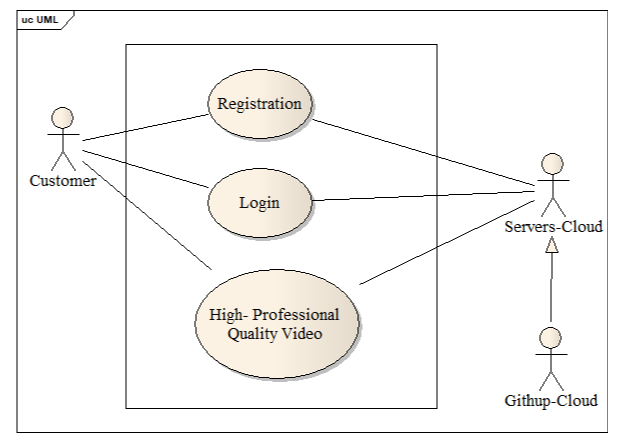
Figure (2): Illustrate the use Case Diagram the basic level for new services for high- professional quality video on cloud environment
3.2 Architecture of The New System
illustrates the components of the new system architecture, which works on the concept of processing high- professional quality video through the Black Box algorithm. The goal is to help the user display high- professional quality video at high speed.in figure (3).

Figure (3): illustrate the architecture of the new system
3.3 Application services component
the components of the computer cloud services are shown and linked to the HTML and database and via mobile. (In figure (4)),
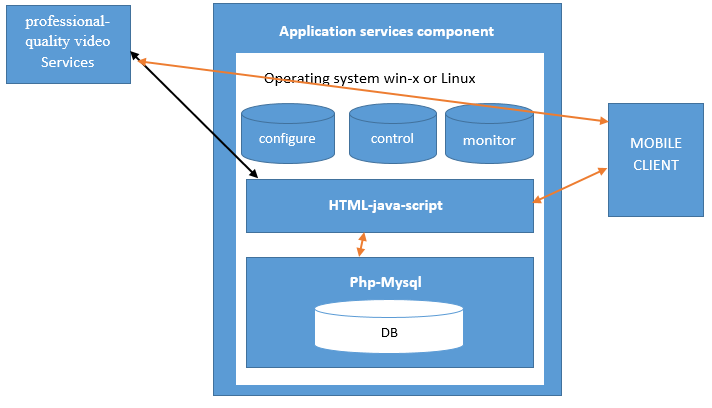
Figure(4) : illustrate the high- professional quality video handling of HTML and database linked to mobile
3.4 Computational of black box over high-quality video
Blackbox program P1 has multiple input and output variables’ is the set of all input variables and Y is the set of all output variables. Test high- professional quality video. for set X can be defined in terms of
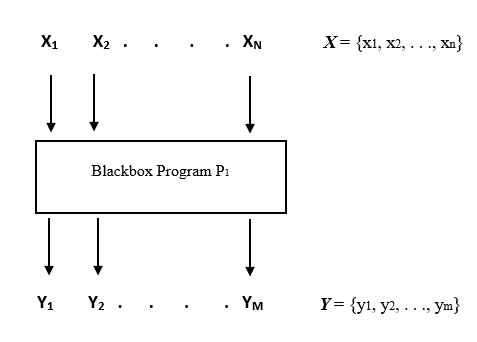
Figure (5): Program P1 with multiple inputs and outputs in black box.
preconditions that describe valid and invalid data values for each input variable x (for the sake of presentation we assume that all input variables are independent), (In Figure 5). These preconditions may be determined from several sources, including the program’s specification and the constraints of the computing environment. To create a test set, it is common to apply black-box test (high- professional quality video), selection criteria to each input variable of X with respect to the preconditions. After applying test selection criteria to each variable of X, we will have a set of tests (high- professional quality) values for each of the input variables: D(x1), D(x2), …, D(xn).
Since Blackbox program P1 (in Figure 5) has multiple input variables, we must now consider how to test combinations of program inputs. The most thorough approach is to test every possible combination of the selected test data values. In such a case, set T of combinatorial tests is the Cartesian product of the test data values of the individual input variables:
T = D(x1) × D(x2) × …× D(xn).
NT, the number of combinatorial tests, is a very large number (NT = |D(x1) |⋅|D(x2) |⋅ … ⋅|D(xn)|).
Explaining from the above idea, more than one entrance (video) can be dealt with at the same time by black box, the idea was taken and amended from scientific paper no [10].
3.5 black box algorithm for high- professional quality video
the idea of a black box algorithm for high- professional quality video is explained, in which the video stages are translated to come out in high- professional quality video mp4 format. The high- professional quality video algorithm was taken from scientific paper No [11].
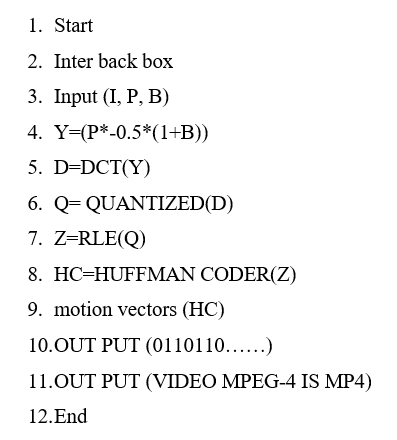
3.6 Activity diagram for black box algorithm for high- professional quality video
the idea of a black box algorithm for high- professional quality video is explained, in which the video stages are translated to come out in high- professional quality video mp4 format. (In Figure 6).
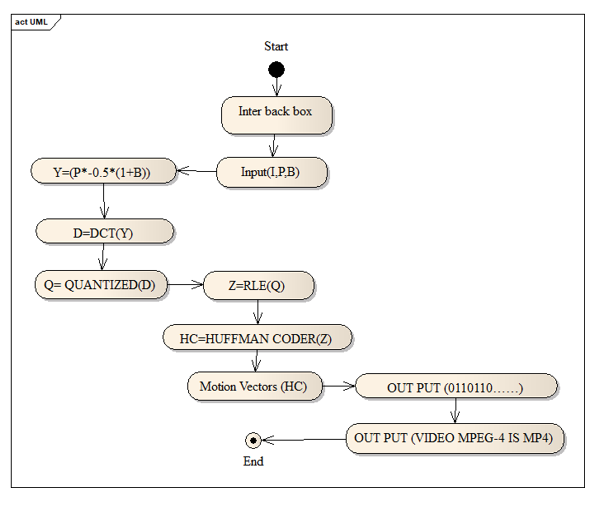
Figure (6): illustrate the Activity diagram for black box algorithm
3.7 System Implementation
A. illustrates the main interface of the cloud environment site, which contains the main page through which the password interface. (In Figure 7).
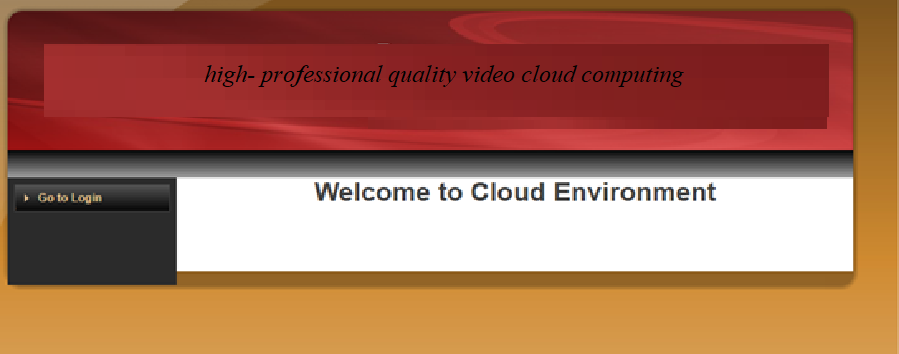
Figure (7): illustrate the main interface of the cloud environment site
B. illustrates the cloud environment’s password interface, which contains the entry of the username and password through which the cloud service. (In Figure 8).
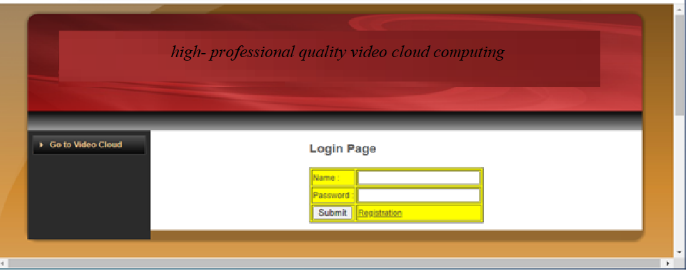
Figure (8): illustrate the cloud environment’s password interface
C. illustrates the user registration interface of the cloud environment site, through which the client’s data is given access to the cloud service interface. (In Figure 9).
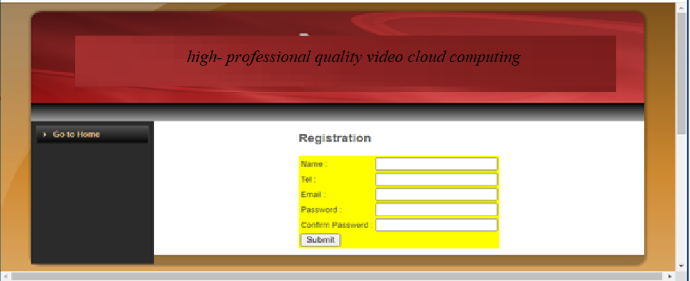
Figure (9): illustrate the user registration interface of the cloud environment site
D. illustrates the video service interface in the black box of the cloud environment site, which contains high- professional quality video through which users can view high- professional quality video in the cloud environment. (In Figure 10).
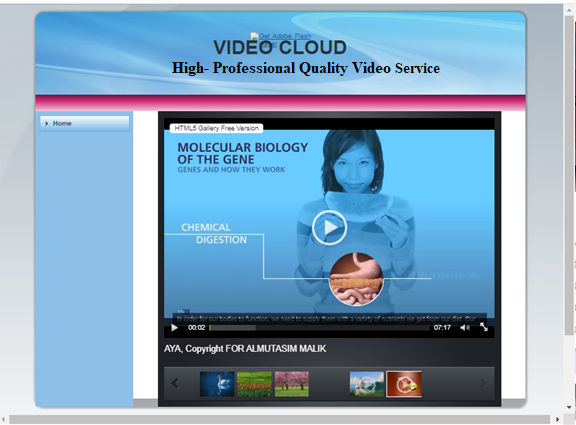
Figure (10): illustrate the high- professional quality video service interface in the black box of the cloud environment site
4.Conclusion
E-evolution, especially in e-learning through the cloud environment, need content that is clear, readable and fast to run or execute. That’s why e-learning has to be clear, especially if the content type is high-quality videos, need high accuracy in running the content, or high speed in running the content.
presented and implemented a Create a new service in the cloud environment (high- professional quality videos -as-a- Service (HPVaaS)). The black box algorithm, through which high- professional quality video pass through, was used.
Also deal with a large number of students, in case of dealing high- professional quality video at the same time, via the black box algorithm. Handles different operating systems, and different devices, all through the cloud environment
References
[1] Dr. Ramalingam Sugumar1, K.Raja2 and other, ” A Study on Enhancing Data Security in Cloud Computing Environment”, International Journal of Computer Science and Mobile Applications, Vol.6 Issue. 3, pg. 44-49, ISSN: 2321-8363 Impact Factor: 5.515, March– 2018.
[2] T. Cucinotta, G. Kousiouris, D. Kyriazis, T. Varvarigou ,” Virtualised e-Learning with Real-Time Guarantees on the IRMOS Platform1 SOCA 2010, 06 December 10.
[3] Prof. Syed Neha Samreen1, Prof. Neha Khatri-Valmik2, Prof. Supriya Madhukar Salve3, Mr. Pathan Nouman Khan 4,” Introduction to Cloud Computing”, International Research Journal of Engineering and Technology (IRJET), e-ISSN: 2395-0056, p-ISSN: 2395-0072, Volume: 05 Issue: 02 | Feb-2018.
[4]https://www.techtarget.com/searchsoftwarequalitydefinition/blackbox#:~:text=Black%20box%20testing%20assesses%20a,entir ly%20by%20inputs%20and%20outputs,2022.
[5] Ghazal Riahi,” E-learning system based on cloud computing”, the 2015 international conference on soft computing and software engineering ,2015.
[6] Darja Krushevskaja, Mark Sandler,” Understanding Latency Variations of Black Box Services”, the International World Wide Web Conference Committee (IW3C2). IW3C2 reserves the right to provide a hyperlink to the author’s site if the Material is used in electronic media. WWW 2013, , Rio de Janeiro, Brazil. ACM 978-1-4503-2035-1/13/05, May 13–17, 2013.
[7] David R. ,Matos Miguel, L. Pardal Miguel Correia,” Rectify: Black-Box Intrusion Recovery in PaaS Clouds”, Las Vegas, NV, USA, 2017 Association for Computing Machinery.ACM ISBN,, December 11–15, 2017.
[8] Shripad Nadgowda, Canturk Isci, Mustafa Bal,” DéjàVu: Bringing Black-box Security Analytics to Cloud”, ACM, New York, NY, USA, 8 pages. https://doi.org/10.1145/3284028.
3284031, December 10–14, 2018.
[9] John Emmons•, Sadjad Fouladi•, Ganesh Ananthanarayanan_, Shivaram Venkataraman⋆, Silvio Savarese•, Keith Winstein,” Cracking open the DNN black-box: Video Analyticswith DNNs across the Camera Cloud Boundary”,ACM,NewYork,NY,USA,https://doi.org/10.1145/3349614.3356023, October 21, 2019.
[10] Patrick J. Schroeder and Bogdan Korel,” Black-Box Test Reduction Using Input-Output Analysis”, ACM 1-58113-266-2/00/0008,2000.
[11] T.Sikora,” MPEG-1 and MPEG-2 Digital Video Coding Standards”, Digital Consumer Electronics Handbook -McGRAW-HILL BOOK COMPANY,2018.
